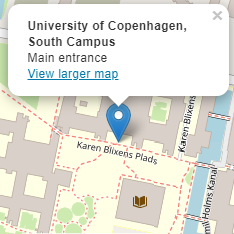The Game of Knowledge
Playing at Spiritual Liberation in 18th- and 19th-Century Western India
Public Defence of PhD thesis by Jacob Schmidt-Madsen.
It has long since been established that the modern children's game of snakes and ladders originated from the Indian game of gyān caupaṛ (game of knowledge), but it has rarely been asked how gyān caupaṛ itself originated, and what exactly constitutes it. The present thesis tells the story of gyān caupaṛ based on nearly 150 unique and mostly unpublished game charts and several little explored secondary sources. The majority of the game charts derive from Vaiṣṇava and Jaina communities in 19th-century western India, though a few reach back to the late 18th century. The thesis argues that the charts developed from tantric drawings of the subtle body used for purposes of meditation and visualization, and only later acquired the properties of a formal game system. Other influences can be traced back to the 12th-century Chinese game of xuanfo tu (table of Buddha selection) and the 15th-century Italian game of gioco dell’oca (game of the goose), but gyān caupaṛ itself does not appear to have been invented before the late 17th or early 18th century. The game charts consist of a sequentially numbered and inscribed grid diagram overlaid with snakes and ladders forming connections between individual squares. The representational value of the charts changes according to the world-views of the different religious communities in which they appear, but they all share a common concern with questions of cosmography, karma, and religious practice. The design is remarkable for its close integration of game mechanics and theme, and while it is possible to reconstruct the rules by which the game was played, little can be said about the uses to which it may have been put beyond that of mere play. Plausible suggestions include education, divination, and self-exploration, but, as evidenced by the later history of the game, such uses have long since fallen away, leaving only the innocent fun of a purely abstract game system.
Det har længe været kendt at det moderne børnespil snakes and ladders stammer fra det indiske spil gyān caupaṛ (videnspillet), men spørgsmål om hvor gyān caupaṛ selv stammer fra, og hvori det rent faktisk består, har sjældent været rejst. Den nærværende afhandling fortæller historien om gyān caupaṛ gennem små 150 unikke og overvejende upublicerede spilleplader samt en række underbelyste sekundære kilder. Størstedelen af spillepladerne stammer fra Vaiṣṇava- og Jaina-miljøer i 1800-tallets vestlige Indien, mens enkelte rækker tilbage til slutningen af 1700-tallet. Afhandlingen argumenterer for at spillepladerne repræsenterer en videreudvikling af tantriske fremstillinger af det astrale legeme til meditations- og visualiseringsbrug der først senere antog karakter af et spil. Andre indflydelser kan spores tilbage til det kinesiske spil xuanfo tu (buddhaudvægelsestabellen) fra 1100-tallet og det italienske spil gioco dell’oca (gåsespillet) fra 1400-tallet, men gyān caupaṛ selv synes først at være blevet til i slutningen af 1600-tallet eller begyndelsen af 1700-tallet. Spillepladerne består af et serielt nummereret og beskrevet feltdiagram med slanger og stiger der forbinder individuelle felter. Spillets repræsentationer veksler afhængig af verdenssynet i de forskellige religiøse miljøer spillepladerne stammer fra, men deler et fælles fokus på kosmografi, karmalære og religiøs praksis. Spildesignet udmærker sig ved en tæt sammenhæng mellem spilmekanik og tematik, og mens det er muligt at rekonstruere de oprindelige regler, er det svært at sige hvilke formål spillet måtte være blevet brugt til ud over ren underholdning. Læring, spådom og selvudforskning regnes alle for plausible forslag, men, som spillets senere historie vidner om, er en sådan brug for længst blevet opgivet til fordel for den uskyldige glæde ved et rent abstrakt spilsystem.
Assessment Committee
- Associate Professor Toke Lindegaard Knudsen, chairman (University of Copenhagen)
- Professor Gudrun Bühnemann (University of Wisconsin at Madison)
- Professor Andreas Bock-Raming (Johannes Gutenberg University)
Moderator of defence
- Head of Department Ingolf Thuesen (University of Copenhagen)
Copies of the thesis will be available for consultation before the defence at the following three places:
- At the Information Desk of Copenhagen University Library, South Campus
- In Reading Room East of the Royal Library (the Black Diamond)
- At Department of Cross Cultural and Regional Studies, Karen Blixens Plads 8, 2300 Copenhagen S

